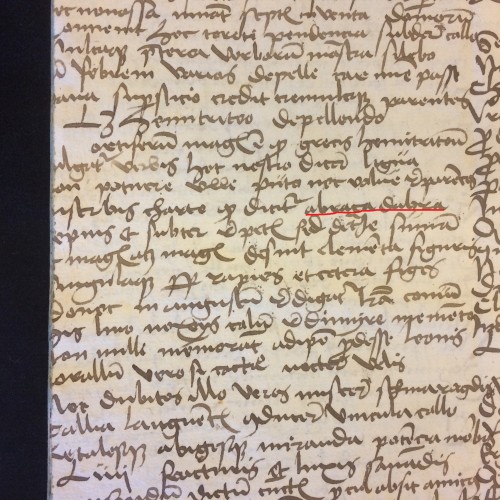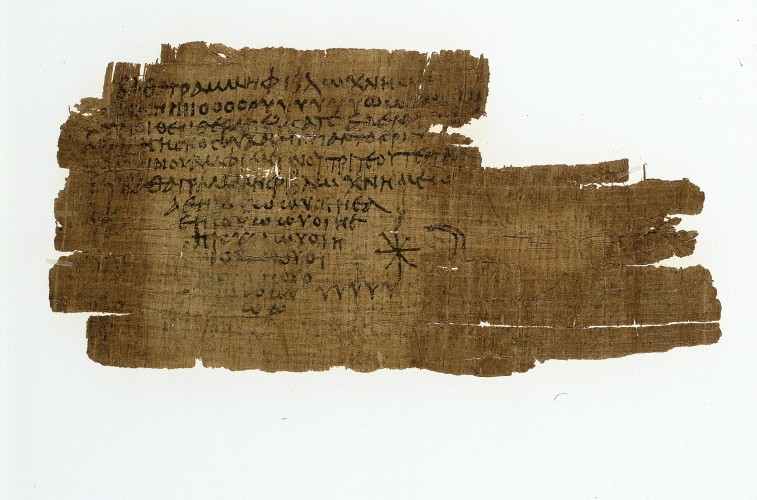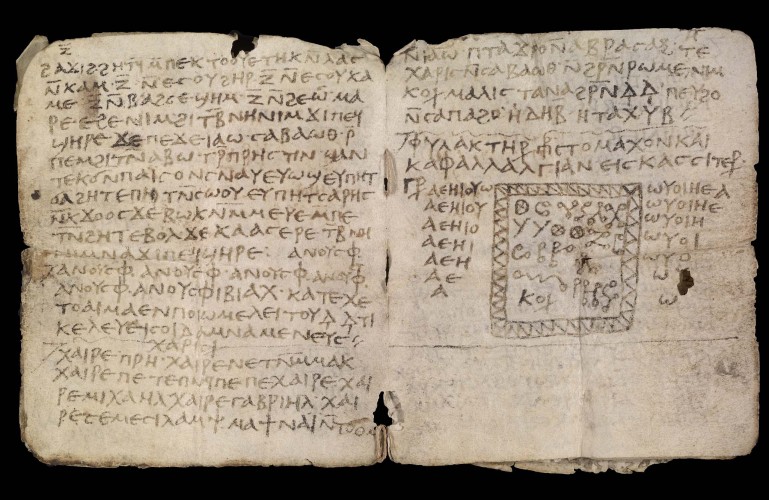The Liber medicinalis (Book of Medicine) is a medical treatise of around 1,200 dactylic hexameters, traditionally attributed to the second-century Roman author, Quintus Serenus Sammonicus (d. beginning of 3rd c. AD). It contains sixty-four therapeutic recipes, divided into two sections: recipes for illnesses affecting individual organs listed from head to toe, and recipes for general ailments like injuries, fevers, fractures and dislocations, insomnia, toothache, and poisoning. This medical poem is part of a collection of medical works and glossaries included in a single quire of twelve leaves on paper, now held at the Special Collections Library. This quire is all that remains from a larger codex, which was copied in southeast Germany or Austria around 1500.

We have underlined the word "abracadabra" on this close-up image of the manuscript. Quintus Serenus (fl. 2nd c. AD). Liber medicinalis. Southeast Germany (Bavaria) or Austria; ca. 1500. Mich. Ms. 291
The Liber medicinalis is often mentioned by scholars of ancient magic because it contains a detailed description of how to make an amulet to combat fever. Serenus prescribes that the magic word “Abracadabra” be written on papyrus and repeated, but after each repetition, that the last letter of the word should be dropped until a single letter is left, so that, by making these letters disappear, the illness will also vanish.
Abracadabra
Abracadabr
Abracadab
…
A
When curating the exhibit, The Art and Science of Healing: From Antiquity to the Renaissance (February 10-April 30 2017), I learned that this magic recipe as reported by Serenus was in fact fairly popular. With small variations, it is found in two manuscripts held at the University of Michigan Library: a third-century papyrus (Papirology Collection) and a sixth-century Coptic codex (Special Collections Library).

Fever Amulet. Egypt; in Greek; 3rd c. AD. Papyrus; 58 x 120 mm. P. Mich. inc. 6666
The papyrus contains a prayer in Greek (lines 3-5), whose English translation is as follows:
Lord Gods, heal Helene, whom so-and-so bore, from every illness and every onslaught of shivering and fever, ephemeral, quotidian, tertian, quartan.
But the most fascinating features of this papyrus do not require knowledge of ancient Greek but an understanding of the rules of ancient magic. Line 2 consists of the seven Greek vowels increasing in number to reach 28: [α ε] ε ηηη ιιιι οοοοο υυυυυυ ωωωωωω[ω]. The number 7 refers to the seven planets – in antiquity defined as seven non-fixed objects visible in the night sky – and the number 28 corresponds to that of the phases of the moon. Hence these vowels might be a magical invocation to the highest deity who controls the movement of the planets and the moon. This symbolism is further emphasized by the drawings of three stars and a lunar crescent surrounding the last lines of the papyrus (7–13). The last lines of the papyrus (7-13) are an interpretation of Serenus'famous rendering of the magical recipe to cure fever. These lines create the shape of an inverted isosceles triangle, which the Greeks called “grape-cluster” or “heart-shape,” formed by gradually losing both the first and last vowels of each line. This is indeed a clever technique to reflect in writing, as Serenus explained, an ancestral oral performance whereby a disease or evil deity was supposedly defeated by progressively reducing its name in speech until reaching complete silence. In our amulet, the fact that the vowels in each line are a palindrome cleverly suggests that what we see as disappearing is not the highest protective deity but rather its evil opposite:
αεηιουωωυοιηεα
εηιουωωυοιηε
ηιουωωυοιη
ιουωωυοι
ουωωυο
υωωυ
ωω

Book of Ritual Spells for Medical Problems. Egypt; in Coptic; 6th c. AD. Manuscript codex on vellum; pp. 6 and 7; 120-102 mm
This small sixth-century Coptic codex held at Special Collections consists of only seven leaves. It contains a fascinating mixture of folk recipes and healing spells, addressing a wide range of medical conditions, such as gout, eye disease, pains from teething, fevers, pregnancy and childbirth, abdominal problems, skin disease, headaches, toothaches, constipation, and even mental problems. And on page 8, we again find a variation of the magical recipe transmitted by Serenus. The author of this particular codex recommends writing on a piece of tin two series of vowels in the shape of inverted isosceles triangles, as each line of the respective series is progressively losing a letter. Though the groups of vowels are interrupted by the drawing of a square with rings inside, it is not hard to realize that the vowels are arranged as a palindrome, so the lines can be read in both ways.
These artifacts, and many others, will be on display in the exhibit, The Art and Science of Healing: From Antiquity to the Renaissance, at the Kelsey Museum of Archaeology and the Audubon Room (Hatcher Library) from February 10th to April 30th, 2017.
STAY TUNED
STAY TUNE
STAY TUN
STAY TU
STAY T
STAY
ST
S